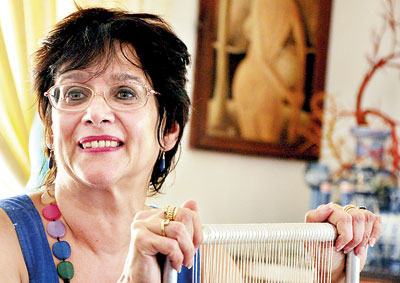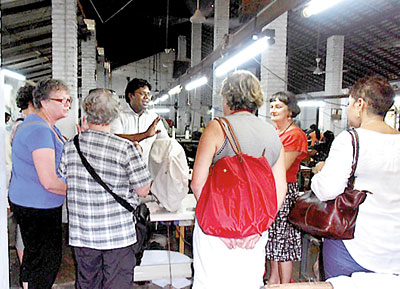Weaving something new in tourism
Sri Lankan born Cresside Collette, a weaver and tapestry artist well-known in Australia led a group of travellers here to explore Sri Lanka through its weaving and garment craft.
A group of tourists is set down at the Galle Face Hotel in Colombo. They travel to Sigiriya, to Kandy and Galle. So far, so predictable.
But these travellers will leave our shores with memories, knowledge and understanding of the island that will enliven their lives for years to come.
What brought them here was interest in exploring Sri Lanka through its ancient and modern heritage of weaving, dyeing and needlework.
These tourists were part of a strong, emerging trend – the niche traveller who explores a country through the lens of a particular line of interest that brings alive a country’s history, culture and way of life in a way that is especially meaningful to that tourist.Sri Lanka has barely tapped the surface of niche tourism but the potential is superb. So far, the push has been led by Sri Lankan-born Australians who, as recognised leaders in their professions, have shown travellers a unique glimpse of this country.
Last month, Cresside Collette, a weaver and tapestry artist whose stunning works hang in boardrooms and galleries around Australia, led a group of travellers to explore Sri Lanka through its weaving and garment craft. In March, the well-liked former deputy prime minister of Australia, Tim Fischer, and railway adventurer Scott McGregor brought railway enthusiasts to Sri Lanka – The Viceroy Special, through Renaissance Tours.

Cresside Collette: Showing travellers a different side of Sri Lanka. Pic by Amila Gamage
In February, acclaimed chef Peter Kuruvita led travellers drawn by the prospect of getting to know the Sri Lankan way of life through its cuisine and cooking traditions. This was so successful that a further World Expeditions tour starts in October and others are planned for 2014.
Active Travel, which introduced the Collette-led “Warp and Weft” tour of Sri Lanka, is considering a later tour embracing more art. A previous tour was centred on architecture.
Who knows, despite the derision by the Colombo set over the battlefield tours of ordinary Sri Lankans to the last scenes of the war with the LTTE, this also might attract foreign tourists given the wide popularity in Australia, Europe, Britain and the United States of tours to the World War I battlefields of the Western Front and Gallipoli, and to Vietnam. For history buffs this subject is fascinating.
Television has brought the scenery and fauna, the palaces and temples of countries around the world to be viewed in as much detail as desired, as often as wished, by people who need never leave their lounge room.
But what is missing is the feel of a country, not the what but the why and how of a civilisation marked by specific art and traditions.
Tours such as Collette’s sparked interest in unlooked for aspects as the tourists visited places such as Ena de Silva’s renowned batik factory at Aluvihare and the Kandygs handloom workshop near Colombo.
“They were fascinated by our social conscience – how often the proprietors engaged with the workers almost like family members and looked after their other interests,” said artist and writer Andrea Boekel, who organised key aspects of the tour for Active Travel.
At Kandygs in Maharagama the tourists heard that the women have flexible working hours, sometimes work week-on and week-off to return to their villages, are fed and accommodated by the handloom factory.
But there was no air-brushing of reality: at a batik factory along the coast the workers were cheerful but, said Collette, the dim and extraordinarily hot conditions just spelled “sweat-shop” to the group. “The open room was dark, dingy and full of fumes, the uneven floor a wax-coated hazard to walk on. By contrast, the batiks produced were a riot of colour and very attractive to the buyer.”
The travellers were struck by the politeness and gentleness with which the workers and artists everywhere explained their craft.
Having generally arrived with preconceptions about Sri Lanka as a shattered country of ill repute from which people were fleeing monsters to seek asylum overseas, the group “found that in fact we are a very educated people” enjoying a steadily improving lifestyle, said Boekel. “They never expected Sri Lanka to be this developed. It dispelled a few myths. By showing them at grassroots level how people really live here, we become ambassadors of Sri Lanka.”

Seeing how it’s done: At the Kandygs factory
In fact, travellers on such tours themselves become ambassadors of Sri Lanka as they are struck by the beauty and richness of life in this country. “I think that they just drank in everything that we showed them,” said Boekel. “And everyone said, ‘We’ll be back’.”
The tourists were introduced to artists and designers such as Marie Gnananraj and Tilak Samarawickrama and were lucky enough to be the first visitors to the Colombo Museum’s new Textile Gallery, where they conversed with Chandramani Thenuwara, the doyenne of textile technology in Sri Lanka.
“It’s important to visit actual designers and creators of textiles and hear about their philosophy of work,” said Collette. “This is also a feature of the Tapestry Tour that I design and run every year to Europe, where we visit practising tapestry artists in their home studios as well as seeing important collections of historical tapestry.”
The museum gallery brought the everyday history of Sri Lanka to life with its display of traditional costumes, local dress through the centuries, and two lines that have especially interested Ms Thenuwara: embroidered betel bags and examples of the “graceful male bathing and running garment dating from mediaeval times”, the diya kachchiya, traditionally woven in black and red on a white background.
There are records of superlative weaving in Sri Lanka from thousands of years ago, Collette told the group: the Ramayana noted that King Ravana wore splendid garments. And the Mahavamsa states that when Prince Vijaya of India arrived in Sri Lanka and met Queen Kuveni, she was spinning yarn.
In Kandy, the tourists saw modern Sri Lanka in an ancient setting – then, unlike others, they drove further into the mountains to talk to weaving families from Henawala and Talaguna, still living the craft-and-cropping tranquil village life as their forebears had done for centuries, each family producing distinctive woven cloth and boiled water reed decorations.
The potential gains for Sri Lanka became immediately clear: “They bought a lot of stuff,” said Boekel. “They also went back and placed a lot of online orders. The travel agency itself came with a big order for travel wallets. So, you can imagine, for all their customers, they would give a wallet and say, ‘This is from craftswomen and men and Sri Lanka. You should go. It’s constant advertising of the country. You can’t quantify it.”
At Ena De Silva’s factory, said Collette, “the tourists were falling over themselves to buy the embroidered cushion covers that they saw took two weeks to make”.
Boekel says the unconsciously cosmopolitan nature of Sri Lankan designs made it easier to display them in a foreign environment. “An Indian wall-hanging is very identifiable as a piece of Indian design. But a Sri Lankan hanging from the Dumbara, for instance, would fit in any bank boardroom in Melbourne. And it’s art that is clever without meaning to be clever.”
Besides handlooms, weaving and Batik the tourists saw the lace-makers of Galle and also a quaint knitting commune where woollen garments are made for a Norwegian market using the traditional “knitting in the round” method that cannot be replicated by machine, giving unthreatened employment to local women. “They do these wonderful, wonderful high-end products for the Norwegian market,” said Boekel. “These were crazy but wonderful insights into the diversity of livelihoods in Sri Lanka.”
The free-wheeling nature of the niche tour programmes and the casual adventurousness of Aussies yielded ad hoc delights such as sampling traditional Lankan ‘tucker’ from roadside shops. “Australians aren’t as picky as some others,” said Boekel. They were into all the ‘pattis’ and ‘cutlis’.
“Niche tourism is a growing market. There is a lot of potential; if there is a tour that seems tailor-made for an individual interest people with a disposable income would say, ‘It’s exactly what we’re looking for’.
Collette, one of Australia’s leading weaving artists and daughter of the famous Lankan-born cartoonist Aubrey Collette, pioneered the art of weaving “en plein air” or straight from nature. “Tapestry is built from the bottom up,” says Collette, describing the challenges of weaving en plein air. “Whatever you weave is going to resonate with what you’ve already got there. You have to be mindful of what has gone before.”
Tapestry, the delicate business of travel – the maxims are the same.
Follow @timesonlinelk
comments powered by Disqus


